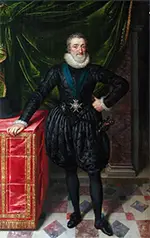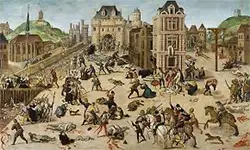The French King Henry IV
Part 1: In the Shadow of Religious Warfare King Henry IV ruled France in the late 16th and early 17th Centuries. He famously ended the Wars of Religion by issuing the Edict of Nantes, which gave religious freedom to the Huguenots. 
He was born on Dec. 13, 1553, in Pau. His mother was Queen Joan III of Navarre and Béarn; his father, King Antoine de Bourbun, was a direct descendant of a previous King of France King Louis IX. The young Henry lived at the royal court for awhile, spending time with the sons of King Henry II, until he was 13, when he returned to Béarn. Back under his mother's tutelage, he learned the arts of warfare and the ways of her religion. Henry's father was Catholic, and the so the boy was baptized in that faith; however, his mother instructed him in the ways of her faith, Calvinism, a Protestant religion. Religious strife was intense in France during this time. A succession of monarchs were Catholic (as had been the case for many years), but a growing number of people in France had embraced the ideas of the well-known Protestant leader John Calvin. In France, these people were called Huguenots. In Navarre, the monarch, Joan, was a Protestant and had the reverse problem. In 1567, she sent royal troops to put down a rebellion by Catholic nobles. Young Henry, then 14, took part in this fighting. He served again the following year, under his brother-in-law, Louis de Bourbon. Louis's forces suffered defeat at the Battle of Jarnac, in March 1569. Henry led a charge of Huguenot cavalry the following year at the Battle of Arnay-le-Duc. Henry studied further military matters, under Gaspard de Coligny. Henry continued to embrace the religious fervor of the Huguenots and took over their army in 1570. He gained even more power in 1572, when his mother died. His father having died a decade earlier, Henry was now King of Navarre. 
In an attempt to keep the peace, Henry married Margaret of Valois, on Aug. 18, 1572. The marriage took place in Paris, a Catholic stronghold. Thousands of Protestants traveled to the capital for the wedding. A week after the wedding, in August 1572, the Duke of Guise, a leader of the Catholic war effort, killed Coligny, a Huguenot leader and Henry's tutor. The violence that followed last five days. Catholics by the thousands targeted Huguenots by the thousands, in what came to be called the St. Bartholomew's Day massacre (right). Estimates of the dead range widely, from a few thousand to tens of thousands. The King at the time was Charles IX. He ordered his childhood playmate Henry to revoke his Protestant faith and be held prisoner at the royal court. This imprisonment continued under Charles's successor, Henry III. The resourceful Navarre monarch, however, escaped, in 1576, renounced his renunciation, and resumed the fight for Huguenot freedom. By this time, however, things looked grim. Henry succeeded in convincing his fellow Huguenot leaders to accept a peace agreement, the Treaty of Bergerac, in September 1577. King Henry III had a brother who was younger than he was. When Henry became king, that brother, Francis, became the Dauphin. Francis died on June 10, 1584, and Henry had no children. Thus was named Henry of Navarre as Dauphin. This did not sit well with the leaders of the Catholic movement in France because Henry was a Protestant. Next page > A Popular King in the End > Page 1, 2 |
|
Social Studies for Kids
copyright 2002–2024
David White




